Concurrent Heat Waves and Extreme Ozone (O3) Episodes: Combined Atmospheric Patterns and Impact on Human Health
Abstract
:1. Introduction
2. Materials and Methods
2.1. Study Area
2.2. Data
2.2.1. Temperature, Relative Humidity, and Ozone Data
2.2.2. Climate Indexes Data
2.2.3. Data Quality Assessment and Control
2.3. Methods
- A hot event is a day that recorded maximum temperature greater than or equal to the 90th percentile;
- A heat wave is a succession of three hot events or more;
- An extreme ozone (O3) event is a day that recorded maximum O3 greater than or equal to the 90th percentile.
3. Results
3.1. Trends in Temperature and Ozone (O3) Extremes
3.2. Concurrence of Heat Waves and Ozone Episodes (O3)
3.3. Heat Waves and Ozone Episodes (O3) Combiend Meteorological Patterns
3.4. Impact of Concurrent Heat Waves and Ozone Episodes (O3) on Human Health
4. Discussion
5. Conclusions
Author Contributions
Funding
Institutional Review Board Statement
Informed Consent Statement
Data Availability Statement
Acknowledgments
Conflicts of Interest
References
- Lin, X.; Yuan, Z.; Yang, L.; Luo, H.; Li, W. Impact of extreme meteorological events on ozone in the pearl river delta, China. Aerosol Air Qual. Res. 2019, 19, 1307–1324. [Google Scholar] [CrossRef]
- Utembe, S.R.; Rayner, P.J.; Silver, J.D.; Guérette, E.A.; Fisher, J.A.; Emmerson, K.M.; Cope, M.; Paton-Walsh, C.; Griffiths, A.D.; Duc, H.; et al. Hot summers: Effect of extreme temperatures on ozone in Sydney, Australia. Atmosphere 2018, 9, 466. [Google Scholar] [CrossRef] [Green Version]
- Rozbicka, K.; Rozbicki, T. Spatiotemporal variations of tropospheric ozone concentrations in the Warsaw Agglomeration (Poland). Ann. Warsaw Univ. Life Sci. Land Reclam. 2015, 46, 247–261. [Google Scholar] [CrossRef] [Green Version]
- Chiquetto, J.B.; Silva, M.E.S.; Cabral-Miranda, W.; Ribeiro, F.N.D.; Ibarra-Espinosa, S.A.; Ynoue, R.Y. Air quality standards and extreme ozone events in the São Paulo megacity. Sustainability 2019, 11, 3725. [Google Scholar] [CrossRef] [Green Version]
- Lin, M.; Horowitz, L.W.; Xie, Y.; Paulot, F.; Malyshev, S.; Shevliakova, E.; Finco, A.; Gerosa, G.; Kubistin, D.; Pilegaard, K. Vegetation feedbacks during drought exacerbate ozone air pollution extremes in Europe. Nat. Clim. Chang. 2020, 10, 444–451. [Google Scholar] [CrossRef]
- Solberg, S.; Hov, Ø.; Søvde, A.; Isaksen, I.S.A.; Coddeville, P.; De Backer, H.; Forster, C.; Orsolini, Y.; Uhse, K. European surface ozone in the extreme summer 2003. J. Geophys. Res. Atmos. 2008, 113, D07307. [Google Scholar] [CrossRef] [Green Version]
- Schnell, J.L.; Prather, M.J. Co-occurrence of extremes in surface ozone, particulate matter, and temperature over eastern North America. Proc. Natl. Acad. Sci. USA 2017, 114, 2854–2859. [Google Scholar] [CrossRef] [PubMed] [Green Version]
- Jacob, D.J.; Winner, D.A. Effect of climate change on air quality. Atmos. Environ. 2009, 43, 51–63. [Google Scholar] [CrossRef] [Green Version]
- Zhang, L.; Cui, Y.Y. Surface ozone interannual variability, trends, and extremes in CCMI models. Atmos. Environ. 2022, 269, 118841. [Google Scholar] [CrossRef]
- Wei, W.; Fang, Y.; Zhou, Y. Synoptic and meteorological drivers of regional ozone pollution events in China. Environ. Res. Commun. 2021, 3, 055004. [Google Scholar] [CrossRef]
- Huang, Q.; Cai, X.; Song, Y.; Zhu, T. Air stagnation in China (1985-2014): Climatological mean features and trends. Atmos. Chem. Phys. 2017, 17, 7793–7805. [Google Scholar] [CrossRef] [Green Version]
- Tan, J.; Zheng, Y.; Tang, X.; Guo, C.; Li, L.; Song, G.; Zhen, X.; Yuan, D.; Kalkstein, A.J.; Li, F.; et al. The urban heat island and its impact on heat waves and human health in Shanghai. Int. J. Biometeorol. 2010, 54, 75–84. [Google Scholar] [CrossRef]
- De Sario, M.; Katsouyanni, K.; Michelozzi, P. Climate change, extreme weather events, air pollution and respiratory health in Europe. Eur. Respir. J. 2013, 42, 826–843. [Google Scholar] [CrossRef] [PubMed] [Green Version]
- Doherty, R.M.; Heal, M.R.; O’Connor, F.M. Climate change impacts on human health over Europe through its effect on air quality. Environ. Health A Glob. Access Sci. Source 2017, 16, 118. [Google Scholar] [CrossRef] [PubMed] [Green Version]
- Cristofanelli, P.; Bonasoni, P.; Carboni, G.; Calzolari, F.; Casarola, L.; Sajani, S.Z.; Santaguida, R. Anomalous high ozone concentrations recorded at a high mountain station in Italy in summer 2003. Atmos. Environ. 2007, 41, 1383–1394. [Google Scholar] [CrossRef]
- Otero, N.; Sillmann, J.; Schnell, J.L.; Rust, H.W.; Butler, T. Synoptic and meteorological drivers of extreme ozone concentrations over Europe. Environ. Res. Lett. 2016, 11, 024005. [Google Scholar] [CrossRef]
- Ji, F.; Evans, J.P.; Di Luca, A.; Jiang, N.; Olson, R.; Fita, L.; Argüeso, D.; Chang, L.T.C.; Scorgie, Y.; Riley, M. Projected change in characteristics of near surface temperature inversions for southeast Australia. Clim. Dyn. 2019, 52, 1487–1503. [Google Scholar] [CrossRef]
- Paton-Walsh, C.; Rayner, P.; Simmons, J.; Fiddes, S.L.; Schofield, R.; Bridgman, H.; Beaupark, S.; Broome, R.; Chambers, S.D.; Chang, L.T.C.; et al. A clean air plan for Sydney: An overview of the special issue on air quality in New SouthWales. Atmosphere 2019, 10, 774. [Google Scholar] [CrossRef] [Green Version]
- Zhang, J.; Gao, Y.; Luo, K.; Leung, L.R.; Zhang, Y.; Wang, K.; Fan, J. Impacts of compound extreme weather events on ozone in the present and future. Atmos. Chem. Phys. 2018, 18, 9861–9877. [Google Scholar] [CrossRef] [Green Version]
- Khomsi, K.; Najmi, H.; Souhaili, Z. Co-occurrence of extreme ozone and heat waves in two cities from Morocco. Satell. Oceanogr. Meteorol. 2018, 3, 733. [Google Scholar] [CrossRef]
- Hssaisoune, M.; Bouchaou, L.; Sifeddine, A.; Bouimetarhan, I.; Chehbouni, A. Moroccan groundwater resources and evolution with global climate changes. Geosciences 2020, 10, 81. [Google Scholar] [CrossRef] [Green Version]
- Khomsi, K.; Najmi, H.; Chelhaoui, Y.; Souhaili, Z. The contribution of large-scale atmospheric patterns to pm10 pollution: The new saharan oscillation index. Aerosol Air Qual. Res. 2020, 20, 1038–1047. [Google Scholar] [CrossRef] [Green Version]
- Cassou, C. Du changement climatique aux régimes de temps: L’oscillation nord-atlantique. Météorologie 2004, 45, 21–32. [Google Scholar] [CrossRef] [Green Version]
- Martin-Vide, J.; Lopez-Bustins, J.A. The Western Mediterranean Oscillation and rainfall in the Iberian Peninsula. Int. J. Climatol. 2006, 26, 1455–1475. [Google Scholar] [CrossRef]
- WMO. Guide to Instruments and Methods of Observation; World Meteorological Organization: Geneva, Switzerland, 2018; ISBN 9789263100085. [Google Scholar]
- Zahumenský, I. Guidelines on quality control procedures for data from automatic weather stations. World Meteorol. Organ. 2004, 2–6. Available online: https://citeseerx.ist.psu.edu/viewdoc/download? (accessed on 12 December 2021).
- WMO. Guidelines on Surface Station Data Quality Control and Quality Assurance for Climate Applications 2021; World Meteorological Organization: Geneva, Switzerland, 2021; ISBN 9789263112699. [Google Scholar]
- World Meteorological Organization (WMO). Climate Data Management System Specifications; World Meteorological Organization: Geneva, Switzerland, 2014; ISBN 9789263111319. [Google Scholar]
- ADEME. Rules and Recommendations concerning: Data validation—Aggregation criteria—Statistical parameters, Technical Coordination of Air Quality Monitoring; ADEME: Paris, France, 2003. [Google Scholar]
- ECMWF Fact Sheet: Reanalysis. Available online: https://www.ecmwf.int/en/about/media-centre/focus/2020/fact-sheet-reanalysis (accessed on 15 February 2022).
- Hersbach, H.; Bell, B.; Berrisford, P.; Hirahara, S.; Horányi, A.; Muñoz-Sabater, J.; Nicolas, J.; Peubey, C.; Radu, R.; Schepers, D.; et al. The ERA5 global reanalysis. Q. J. R. Meteorol. Soc. 2020, 146, 1999–2049. [Google Scholar] [CrossRef]
- Simolo, C.; Brunetti, M.; Maugeri, M.; Nanni, T.; Speranza, A. Understanding climate change-induced variations in daily temperature distributions over Italy. J. Geophys. Res. Atmos. 2010, 115, D22110. [Google Scholar] [CrossRef]
- Khomsi, K.; Mahe, G.; Tramblay, Y.; Sinan, M.; Snoussi, M. Regional impacts of global change: Seasonal trends in extreme rainfall, run-off and temperature in two contrasting regions of Morocco. Nat. Hazards Earth Syst. Sci. 2016, 16, 1079–1090. [Google Scholar] [CrossRef] [Green Version]
- Theil, H. A rank-invariant method of linear and polynomial regression analysis. I. Nederl. Akad. Wetensch. Proc. 1950, 53, 386–392. [Google Scholar] [CrossRef]
- Sen, P.K. Estimates of the Regression Coefficient Based on Kendall’s Tau. J. Am. Stat. Assoc. 1968, 63, 1379. [Google Scholar] [CrossRef]
- Kahsay, K.D.; Pingale, S.M.; Hatiye, S.D. Impact of climate change on groundwater recharge and base flow in the sub-catchment of Tekeze basin, Ethiopia. Groundw. Sustain. Dev. 2018, 6, 121–133. [Google Scholar] [CrossRef]
- Byakatonda, J.; Parida, B.P.; Kenabatho, P.K.; Moalafhi, D.B. Analysis of rainfall and temperature time series to detect long-term climatic trends and variability over semi-arid Botswana. J. Earth Syst. Sci. 2018, 127, 25. [Google Scholar] [CrossRef] [Green Version]
- Hamed, K.H.; Ramachandra Rao, A. A modified Mann-Kendall trend test for autocorrelated data. J. Hydrol. 1998, 204, 182–196. [Google Scholar] [CrossRef]
- Méndez-Lázaro, P.; Muller-Karger, F.E.; Otis, D.; McCarthy, M.J.; Peña-Orellana, M. Assessing climate variability effects on dengue incidence in San Juan, Puerto Rico. Int. J. Environ. Res. Public Health 2014, 11, 9409. [Google Scholar] [CrossRef] [Green Version]
- Steadman, R.G. The Assessment of Sultriness. Part II: Effects of Wind, Extra Radiation and Barometric Pressure on Apparent Temperature. J. Appl. Meteorol. 1979, 18, 874–885. [Google Scholar] [CrossRef] [Green Version]
- Steadman, R.G.; Steadman, R.G. The Assessment of Sultriness. Part I: A Temperature-Humidity Index Based on Human Physiology and Clothing Science. J. Appl. Meteorol. 1979, 18, 861–873. [Google Scholar] [CrossRef] [Green Version]
- Stieb, D.M.; Burnett, R.T.; Smith-Doiron, M.; Brion, O.; Hwashin, H.S.; Economou, V. A new multipollutant, no-threshold air quality health index based on short-term associations observed in daily time-series analyses. J. Air Waste Manag. Assoc. 2008, 58, 435–450. [Google Scholar] [CrossRef] [Green Version]
- Filahi, S.; Tanarhte, M.; Mouhir, L.; El Morhit, M.; Tramblay, Y. Trends in indices of daily temperature and precipitations extremes in Morocco. Theor. Appl. Climatol. 2016, 124, 959–972. [Google Scholar] [CrossRef]
- Donat, M.G.; Peterson, T.C.; Brunet, M.; King, A.D.; Almazroui, M.; Kolli, R.K.; Boucherf, D.; Al-Mulla, A.Y.; Nour, A.Y.; Aly, A.A.; et al. Changes in extreme temperature and precipitation in the Arab region: Long-term trends and variability related to ENSO and NAO. Int. J. Climatol. 2014, 34, 581–592. [Google Scholar] [CrossRef]
- Driouech, F.; Stafi, H.; Khouakhi, A.; Moutia, S.; Badi, W.; ElRhaz, K.; Chehbouni, A. Recent observed country-wide climate trends in Morocco. Int. J. Climatol. 2020, 41, E855–E874. [Google Scholar] [CrossRef]
- Reliefweb Morocco: Cold Wave–January 2018. Available online: https://reliefweb.int/disaster/cw-2018-000008-mar (accessed on 15 February 2022).
- Khadija, H.; Lahcen, B. The Carbon monoxide (CO) contribution in the air pollution case of the Greater Casablanca Region, Morocco. J. Ind. Pollut. Control 2017, 33, 1509–1513. [Google Scholar]
- Inchaouh, M.; Tahiri, M. Air pollution due to road transportation in Morocco: Evolution and impacts. J. Multidiscip. Eng. Sci. Technol. 2017, 4, 7547–7552. [Google Scholar]
- Inchaouh, M. State of Ambient Air Quality in Marrakech City (Morocco) over the Period 2009–2012. Int. J. GEOMATE 2017, 12, 99–106. [Google Scholar] [CrossRef]
- Ouarzazi, J.; Terhzaz, M.; Abdellaoui, A.; Bouhafid, A.; Nollet, V.; Dechaux, J.-C. Etude descriptive de la mesure de polluants atmosphériques dans l’agglomération de Marrakech. Pollut. Atmos. 2003, 45, 137–151. [Google Scholar] [CrossRef] [Green Version]
- Tramblay, Y.; Badi, W.; Driouech, F.; El Adlouni, S.; Neppel, L.; Servat, E. Climate change impacts on extreme precipitation in Morocco. Glob. Planet. Chang. 2012, 82–83, 104–114. [Google Scholar] [CrossRef]
- Chen, Z.; Li, R.; Chen, D.; Zhuang, Y.; Gao, B.; Yang, L.; Li, M. Understanding the causal influence of major meteorological factors on ground ozone concentrations across China. J. Clean. Prod. 2019, 242, 118498. [Google Scholar] [CrossRef]
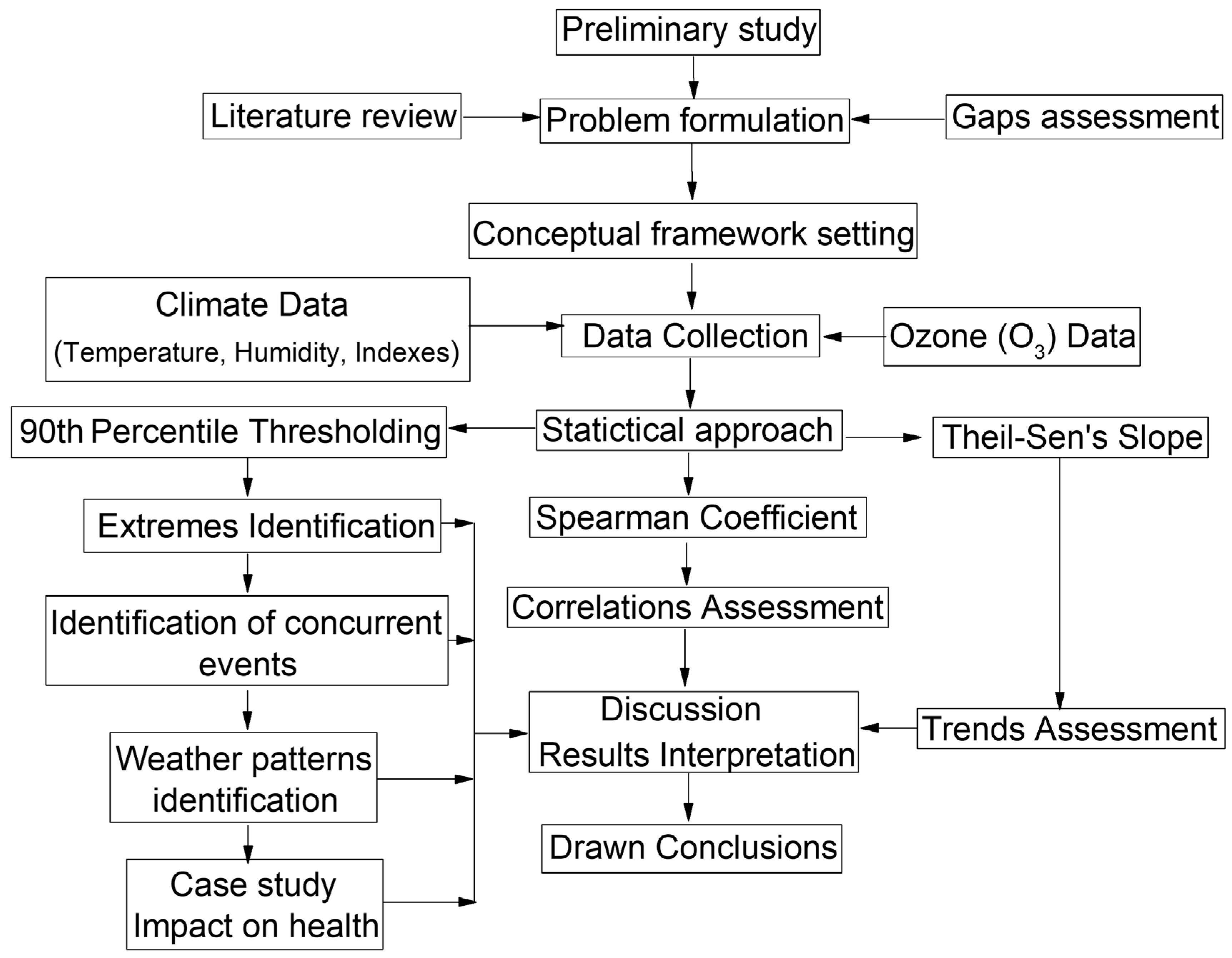
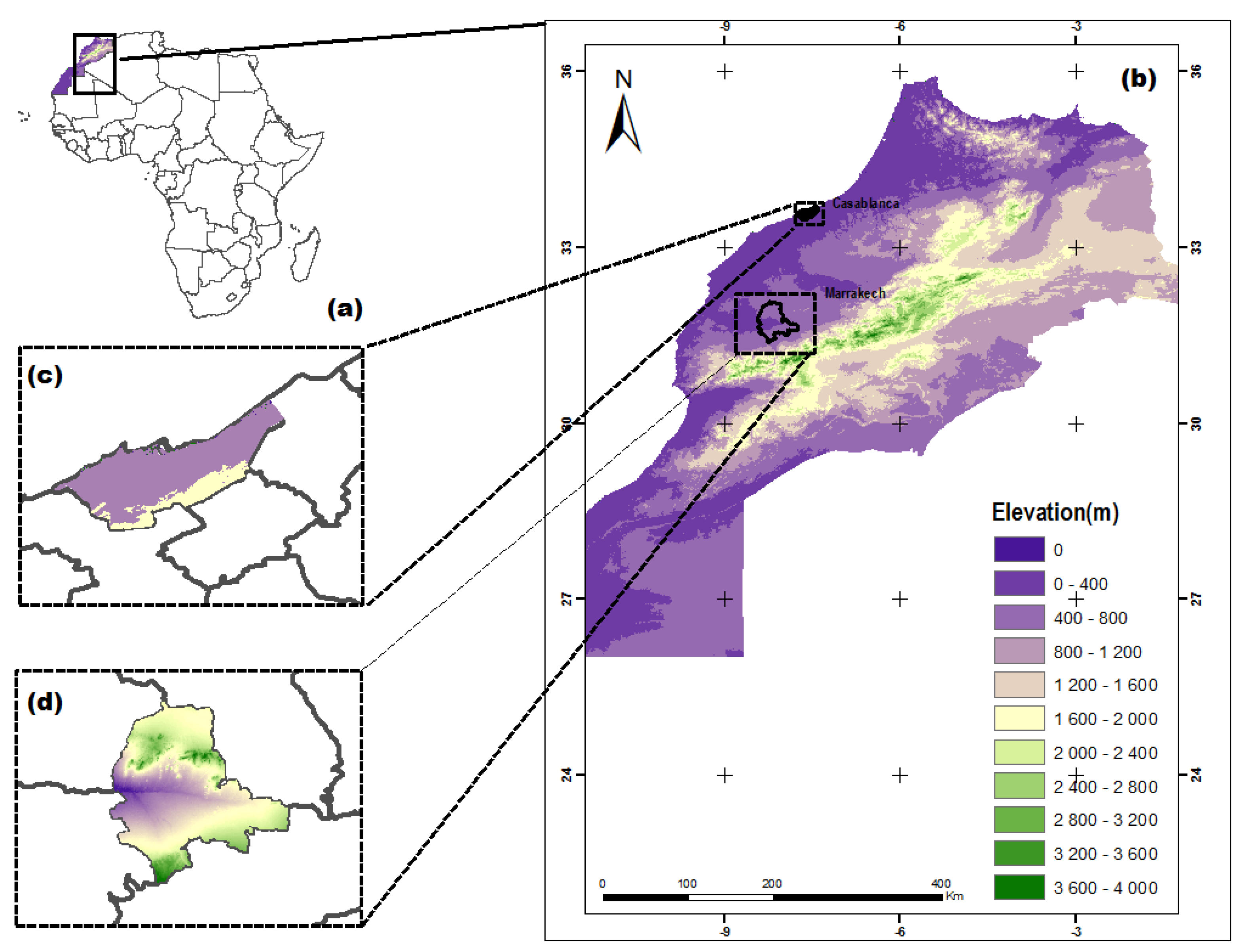
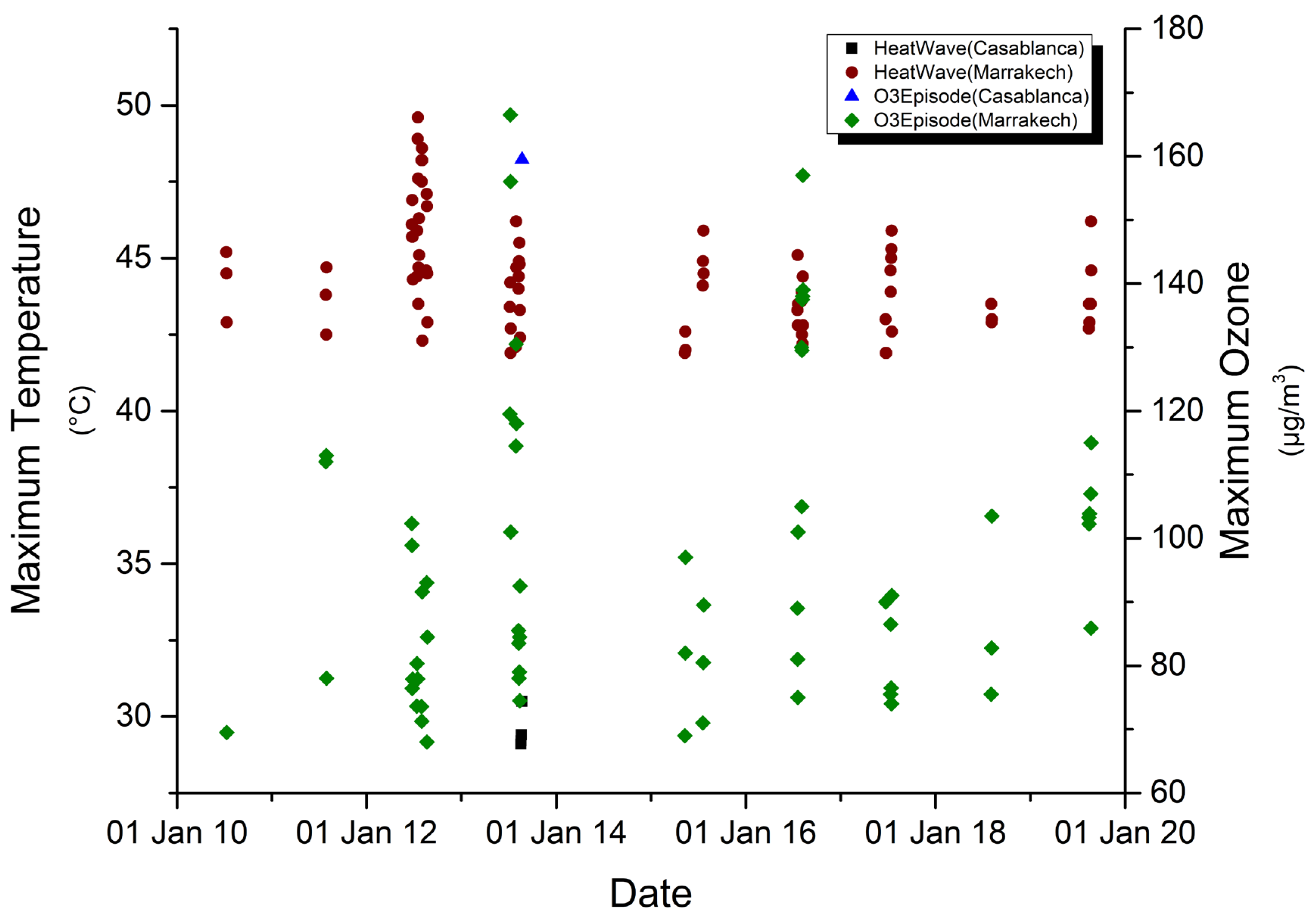
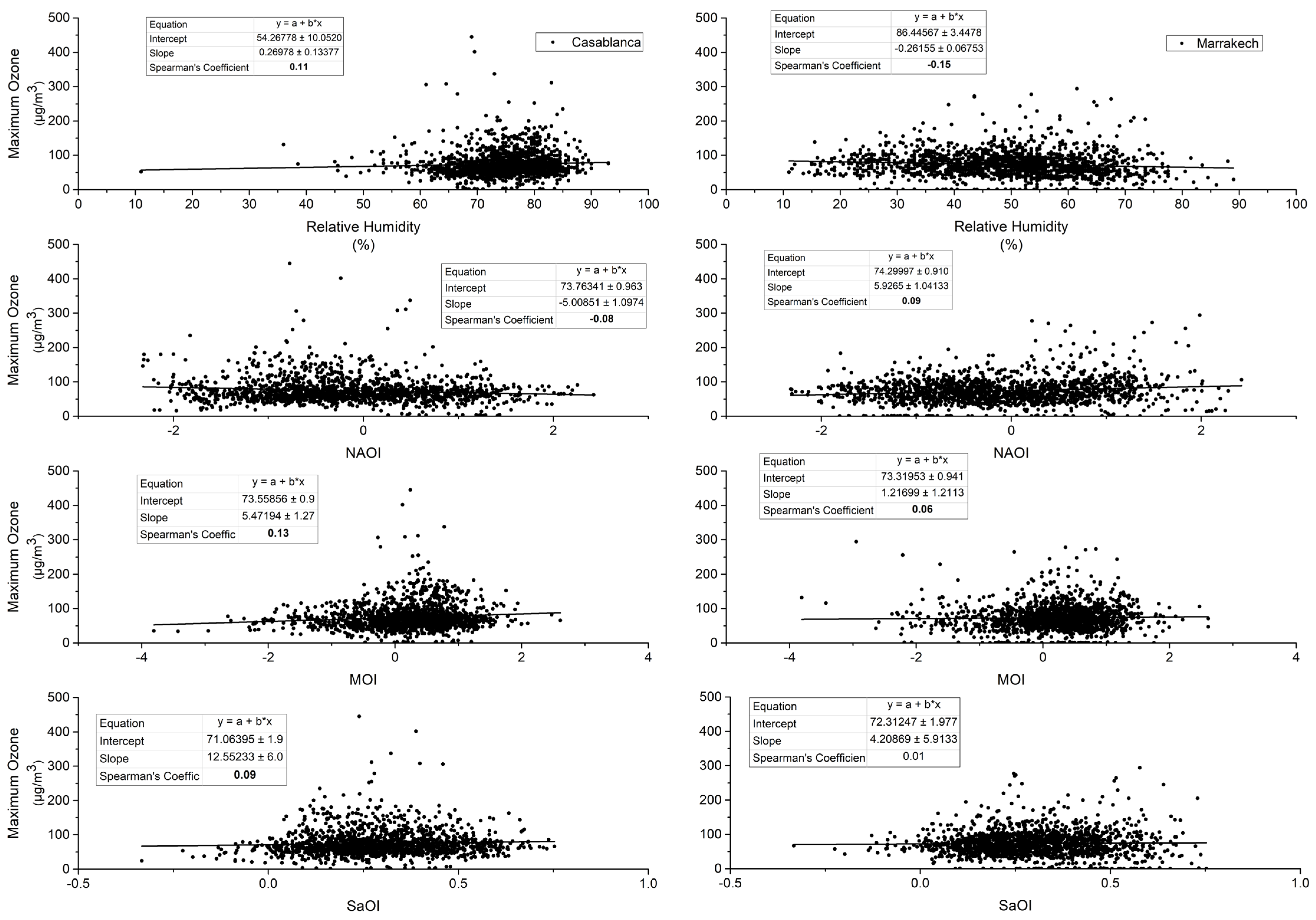
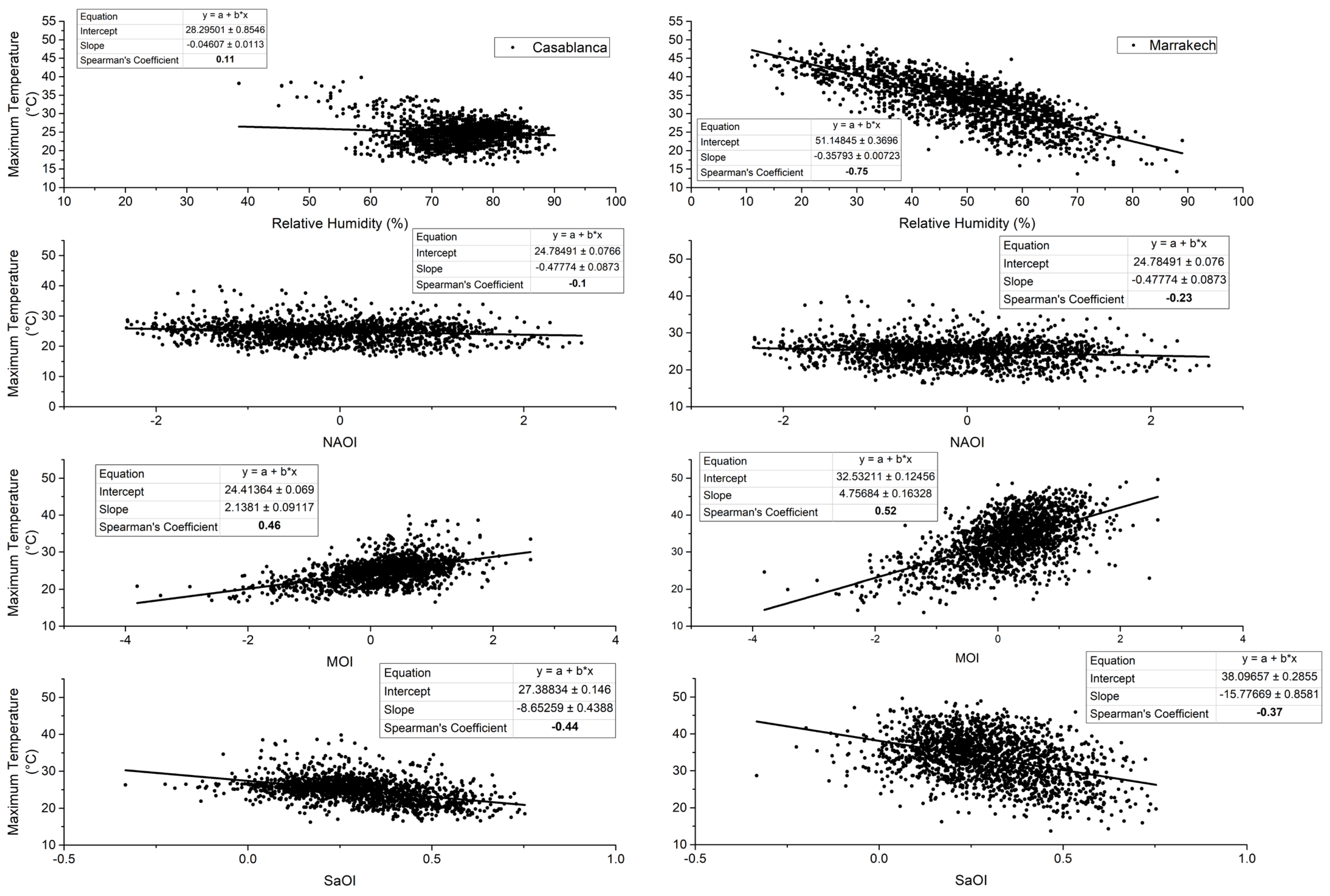
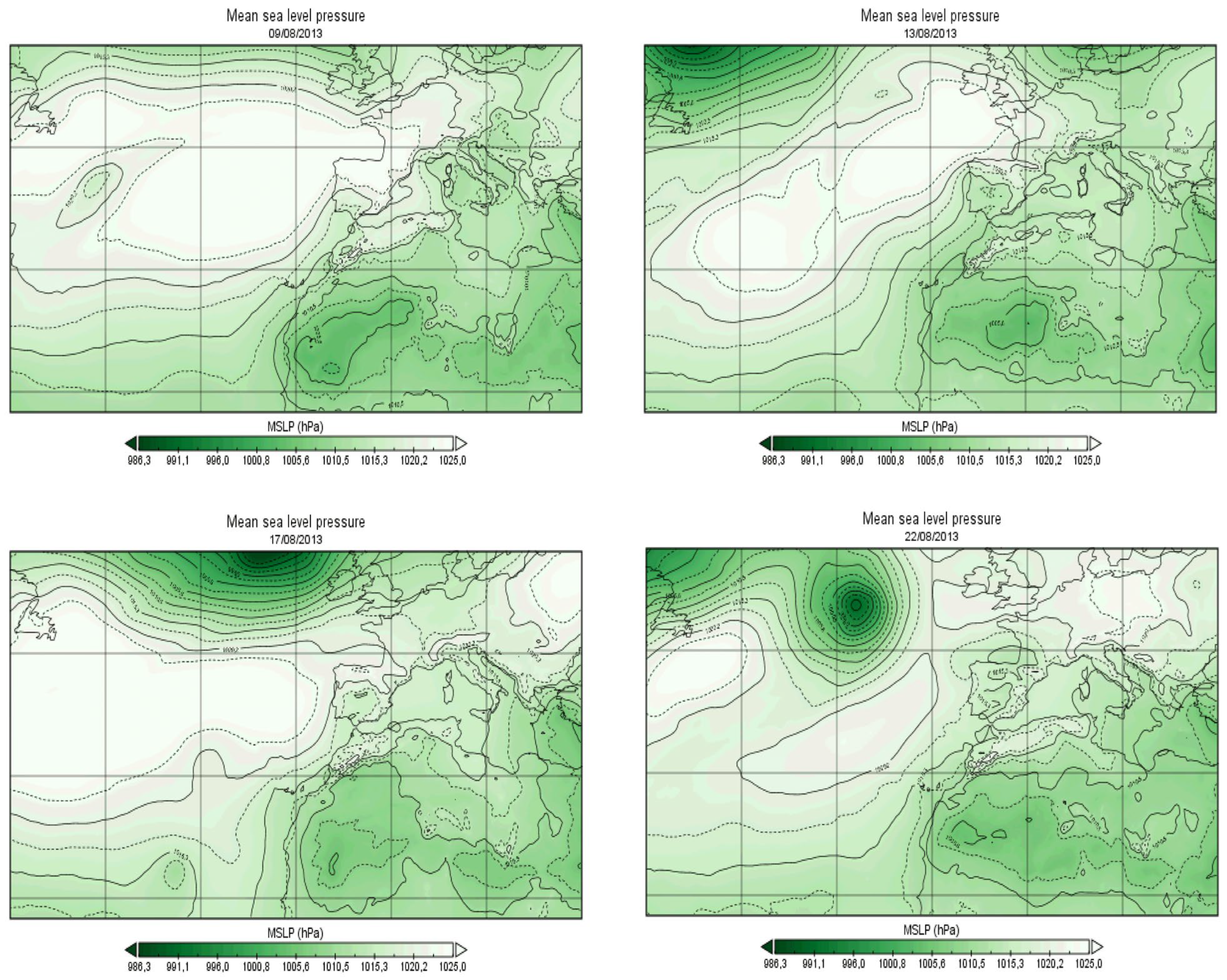
| Temperature (°C) | Impact on Human Comfort |
|---|---|
| 27–32 °C | Caution fatigue is possible with prolonged exposure and activity. Continuing activity could result heat cramps. |
| 32–41 °C | Extreme caution: heat cramps and heat exhaustion are possible. Continuing activity could result in heat stroke. |
| 41–54 °C | Danger: heat cramps and heat exhaustion are likely; heat stroke is probable with continued activity. |
| Over 54 °C | Extreme danger: heat stroke is imminent. |
| AQHI | Health Risk |
|---|---|
| 1–3 | Low Risk |
| 4–6 | Moderate Risk |
| 7–10 | High Risk |
| Above 10 | Very High Risk |
| Theil-Sen’s Slope | Casablanca | Marrakech |
|---|---|---|
| Yearly Tmax (°C/decade) | −0.08 | 0.04 |
| Yearly O3max (µg·m−3/decade) | −4.38 | 5.78 |
| Tmax percentile °C/decade) | −0.11 | −4.23 |
| O3max percentile (µg·m−3/decade) | −0.21 | 7.64 |
| Heat waves (heat wave/decade) | −1.25 | −0.25 |
| O3 episodes (episode/decade) | 0 | 0.8 |
| Days of the Episode | Casablanca | Marrakech | ||
|---|---|---|---|---|
| Heat Risk | Air Quality Risk | Heat Risk | Air Quality Risk | |
| 9 August 2013 | No Risk | High Risk | Extreme Caution | High Risk |
| 10 August 2013 | No Risk | High Risk | Extreme Caution | High Risk |
| 11 August 2013 | No Risk | Very High Risk | Extreme Caution | Moderate Risk |
| 12 August 2013 | No Risk | High Risk | Extreme Caution | Moderate Risk |
| 13 August 2013 | No Risk | Moderate Risk | Extreme Caution | High Risk |
| 14 August 2013 | No Risk | Moderate Risk | Extreme Caution | Moderate Risk |
| 15 August 2013 | No Risk | Moderate Risk | Extreme Caution | High Risk |
| 15 August 2013 | No Risk | Moderate Risk | Caution | High Risk |
| 17 August 2013 | No Risk | Moderate Risk | No Risk | Moderate Risk |
| 18 August 2013 | No Risk | Moderate Risk | Caution | High Risk |
| 19 August 2013 | No Risk | High Risk | Caution | High Risk |
| 19 August 2013 | No Risk | High Risk | Extreme Caution | High Risk |
| 21 August 2013 | No Risk | Moderate Risk | Caution | High Risk |
| 22 August 2013 | No Risk | Moderate Risk | Caution | Moderate Risk |
Publisher’s Note: MDPI stays neutral with regard to jurisdictional claims in published maps and institutional affiliations. |
© 2022 by the authors. Licensee MDPI, Basel, Switzerland. This article is an open access article distributed under the terms and conditions of the Creative Commons Attribution (CC BY) license (https://creativecommons.org/licenses/by/4.0/).
Share and Cite
Khomsi, K.; Chelhaoui, Y.; Alilou, S.; Souri, R.; Najmi, H.; Souhaili, Z. Concurrent Heat Waves and Extreme Ozone (O3) Episodes: Combined Atmospheric Patterns and Impact on Human Health. Int. J. Environ. Res. Public Health 2022, 19, 2770. https://doi.org/10.3390/ijerph19052770
Khomsi K, Chelhaoui Y, Alilou S, Souri R, Najmi H, Souhaili Z. Concurrent Heat Waves and Extreme Ozone (O3) Episodes: Combined Atmospheric Patterns and Impact on Human Health. International Journal of Environmental Research and Public Health. 2022; 19(5):2770. https://doi.org/10.3390/ijerph19052770
Chicago/Turabian StyleKhomsi, Kenza, Youssef Chelhaoui, Soukaina Alilou, Rania Souri, Houda Najmi, and Zineb Souhaili. 2022. "Concurrent Heat Waves and Extreme Ozone (O3) Episodes: Combined Atmospheric Patterns and Impact on Human Health" International Journal of Environmental Research and Public Health 19, no. 5: 2770. https://doi.org/10.3390/ijerph19052770
APA StyleKhomsi, K., Chelhaoui, Y., Alilou, S., Souri, R., Najmi, H., & Souhaili, Z. (2022). Concurrent Heat Waves and Extreme Ozone (O3) Episodes: Combined Atmospheric Patterns and Impact on Human Health. International Journal of Environmental Research and Public Health, 19(5), 2770. https://doi.org/10.3390/ijerph19052770







